Arrive Mumbai by SQ-424 at 2145 Hrs.
On your arrival, after clearing immigrations, you will be met by Mysteries of India’s representative who will escort you to your hotel.
Mumbai (formerly Bombay), the gateway to India in the days of the British Raj, is today India's commercial capital. The city dates back to around the first century AD, when the area consisted of seven islands separated by the sea. In 1661 the Portuguese presented the port and islands of Bombay to the British, and in 1668 the East India Company leased all of the islands from the British Government for £10.00 in gold per year.
On independence in 1947 the Bombay presidency became Bombay state, and subsequently Bombay became the state capital of Maharashtra. Today Mumbai is a fascinating crossroads of the east and west where the sophistication and technology of the first world is combined with the eastern ability to sell almost anything against a backdrop of oriental colour and scent. Besides being the major port Mumbai is the most cosmopolitan, fastest moving, affluent and industrialized city in India. It is India's financial, commercial and industrial centre, and the hub of the film industry (Bollywood).
Check in at the hotel & spend rest of the evening at leisure.
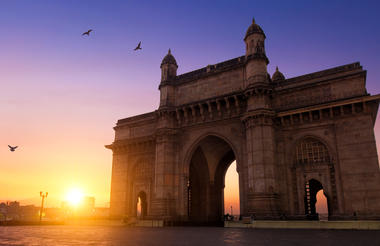
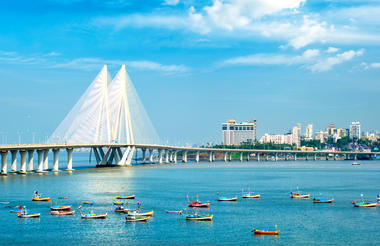
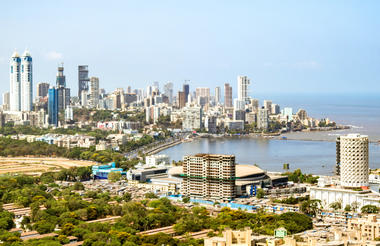
00:00
After breakfast, proceed for Elephanta Island Excursion.
Morning visit to the Gateway of India and Elephanta Island. The Gateway of India, Mumbai's most striking monument, is an imposing arch in the Indo-Saracenic style with Gujarati and Islamic elements. It was built to commemorate the visit of King George V and Queen Mary to India in 1911. Near the Gateway is a statue of Shivaji, the 17th century founder of the independent Hindu Kingdom of Maharashtra.
An hour's boat-ride, 6 miles across the Arabian Sea from Gateway, is the small but celebrated island of Elephanta, famous for its Elephanta Cave Temples. Carved into the island’s solid stone, the base relief carvings are magnificent. The Portuguese renamed this island Elephanta after a large stone elephant found near the shore. (Closed on Mondays).
Afternoon sightseeing of the city, visiting the Prince of Wales Museum, Mani Bhawan, Dhobi Ghat, Crawford Market and Drive along Marine Drive.
Princes of Wales Museum: Chhatrapati Shivaji Maharaj Museum previously known as Princes of Wales Museum was built to commemorate the visit of the King George V’s first visit to India in 1905 when he was still the Prince of Wales, and opened in 1914. With sections on art, archaeology and natural history, it houses rare and ancient exhibits of India’s history as well as objects from foreign lands. Also Indus Valley Civilization artefacts, relics from ancient India and examples of Mauryan Art. (Closed on Mondays).
Mani Bhawan: This is where Mahatma Gandhi stayed when he visited Mumbai between 1917 and 1934. He preached Ahimsa or Non-violence, and it was here that his association with the charkha or spinning wheel began in 1917. It now houses a picture gallery, a 20,000-volume research library and a film and recording archive.
Dhobi Ghat: A unique feature of Mumbai, the dhobi is a traditional laundryman, who will collect your dirty linen, wash it, and return it neatly pressed to your doorstep. At Dhobi Ghat the clothes are soaked in lather water, then thrashed on the stones, later thrown into huge vats of boiling starch and then hung out to dry.
Marine Drive: also known as the "Queen's Necklace" is a pleasant drive along the shoreline of Back Bay, from Nariman Point past Chowpatty and up to Malabar Hill.
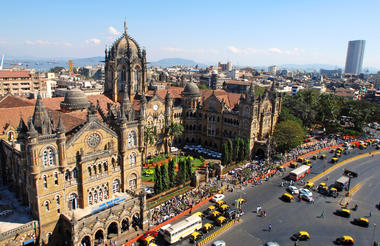
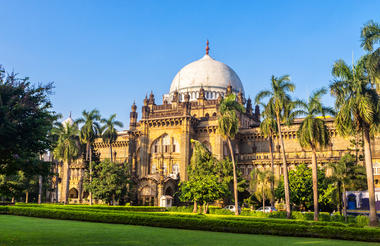
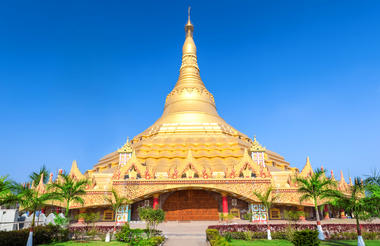
After breakfast, check out & transfer to airport to board the flight to Udaipur.
Mumbai – Udaipur Indigo Airlines 6E-749
Departs1215 Arrives1345Economy class
On your arrival, you will be met by representative who will escort you to your hotel.
Udaipur, the 'City of Dreams' also known as the Venice of the East, is interspersed with shimmering lakes, marble palaces and fountains. It is often referred to as the most romantic city in India. It was built in traditional Rajput style in 1559 A.D. by Maharana Udai Singh and was originally the capital of the State of Mewar. It's beautiful lake setting; graceful architecture, bustling bazaars and historical past make Udaipur rather special.
Check in at the hotel & spend rest of the day at leisure.
Enjoy Christmas Eve Gala Dinner at your hotel.
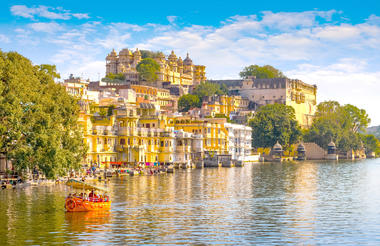
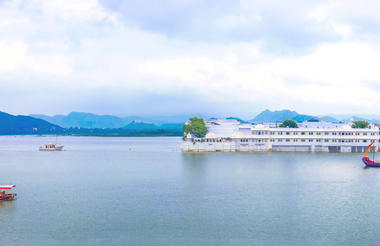
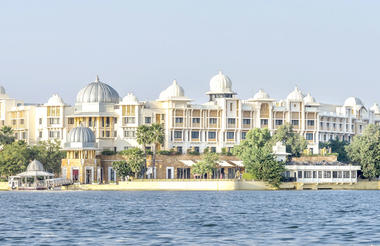
Breakfast at your hotel.
Later proceed for Morning city tour includes the City Palace & Museum, Jagdish Temple and the Sahelion ki Bari (Garden of the maids of honour).
The grand City Palace towers over the Pichola Lake. Maharana Uday Singh initiated its construction and succeeding Maharanas added several palaces to the complex but retained a surprising uniformity to the design. The main part of the palace is now a museum displaying a large and diverse array of artefacts, the Crystal Gallery having a breathtaking collection of crystal.
Jagdish Temple: The exterior and the plinth are covered with superb base reliefs of alligators, elephants, horsemen and celestial musicians rising in tiers. Chanting, bells and music can be heard throughout the day.
Sahelion Ki Bari: Known as the Gardens of the Maids of Honour, and built in the 18th century by Maharana Sangram Singh, these delightful gardens are discreet and in impeccable taste. The fountains of the Sahelion ki Bari function solely by water pressure with no pumps being used.
Evening exclusive boat ride at Lake Pichola.
An evening boat ride on Lake Pichola cruises the city waterfront, bathing Ghats, and out to Jag Mandir. Lake Pichola derives its name from Pichola Village, which was submerged when Maharana Udai Singh enlarged the lake after he founded the city.
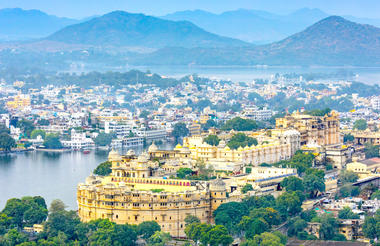
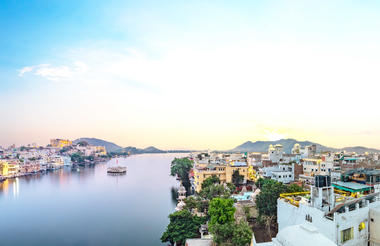
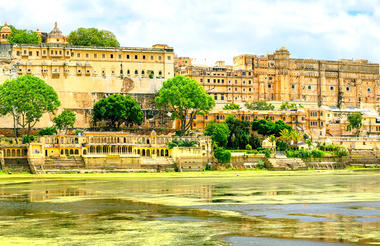
After breakfast, check out & drive to Rawla Narlai.
Rawla Narlai is situated in the heart of a typical Rajasthani village, bustling with activity and colour. The fortress is an oasis of serenity and offers a breathtaking view of a magnificent volcanic granite rock measuring 350ft in height. By exploring the Godward region it is possible, on “Royal” horses, to discover the dense Aravil forest or Lake Chakar. Camel Safaris, trekking and rock climbing are activities that are also available.
Check in at the hotel.
Later in the day proceed for Village walk with hotel staff.
The Village walk at Narlai is an excursion into the village to look at the traditional way people live even today. Narlai is a very close-knit community and each person comes across happy, contented and proud. Agriculture, cattle and its supporting income make them content with a simple life. During the walk you can go inside some of the houses, talk to people, ask questions, have a cup of tea or smoke a bidi (local cigarette) with them. The Village walk is ideally done in morning before the villagers depart for grazing or in the evening during their return.


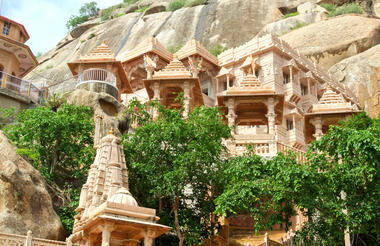
Early morning, proceed for Leopard Safari for 3Hrs (Starts around 0530Hrs onwards).
The rugged Godwad countryside around Narlai suits the leopards and over a period the number has increased. Experience the thrill of customized ride on our jeeps for a sighting of this beautiful and graceful cat. Not easy to spot as they blend very well into the background, these cats can sometimes be seen sunning themselves on the rocks or resting under the shade of a tree. Unlike the lions, leopards do not stay in a pride and are solitary by nature and have large territories that they roam in. But sometimes they can be spotted in pairs.
After breakfast, check out & drive to Jodhpur.
Rao Jodha, the chief of the Rajput clan called the Rathores, founded the Bustling desert city of Jodhpur in 1459. It became the centre of the Rathore Kingdom known as Marwar, and lies in the heart of Rajasthan and on the edge of the Thar Desert. The massive fort dominates the city, topping a rocky hill that rises in its centre. The old city is surrounded by a 10 Km wall, from which eight gates give entry and exit.
Check in at the hotel & spend rest of the day at leisure.
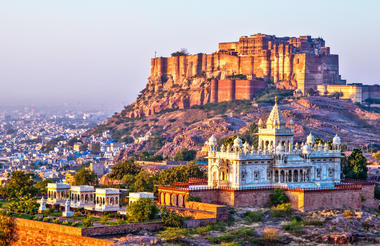
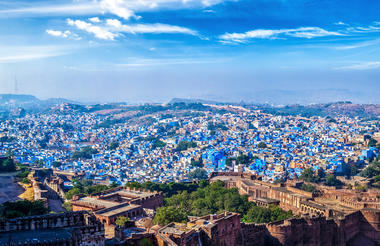
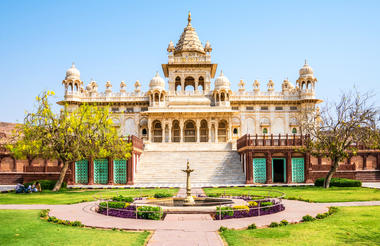
The Raas is very close to the Old City Market. You may like to wander through this area and check out the Clock Tower at the same time. The Raas has a lovely dining area outside so you can enjoy the view of the fort but just down the road on the roof of the Pal Haveli you can have a less expensive meal and the setting is beautiful with a view of the fort.
Breakfast at the hotel.
Morning visit Mehrangarh Fort & Jaswant Thada.
Mehrangarh Fort: Perched on a 125 m high hill the fort was founded in 1459. It is both impressive and formidable in both its location and construction. On the ramparts is a rare collection of canon, and battle scars from canon ball hits can still be seen on one of the gates. Within the fort are magnificent palaces, with meticulously carved panels and latticed windows or "Jarokhas". The chambers have evocative names - Moti Mahal, Phool Mahal, Sheesh Mahal, the Sileh Khana and the Daulat Khana reflect the splendour of a bygone era.
Jaswant Thada: This graceful white marble cenotaph is the memorial to Maharaja Jaswant Singh II, and was built in 1899. The main memorial is built like a temple, with intricately carved marble. Located in stark and rocky terrain it has a secluded and a mystic aura.
Afternoon jeep safari to a Bishnoi village. The Bishnoi (followers of Guru Jamboji of the 15th century, and his 29 principles) have protected nature for more than 500 years, and are arguably some of the world’s 'Premier Ecologists”.
Bishnoi’s are strong lovers of trees and animals and are responsible for the survival of species like the Black Buck Antelope (India's most beautiful antelope and a rare and protected species today).
They share a close and special relationship with this endangered animal, wherein the antelope stays close to Bishnoi habitation, never leaving it, and displays complete trust in the Bishnoi people.
Overnight in Jodhpur
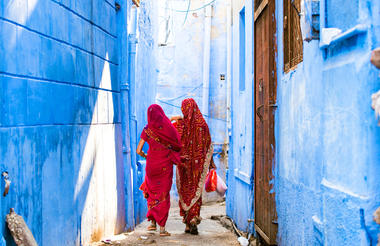
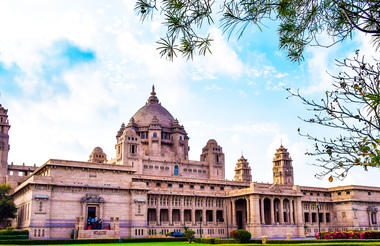
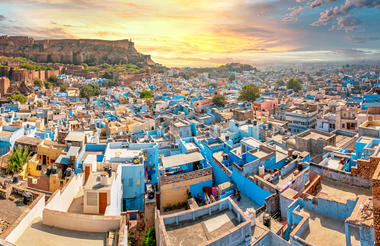
After breakfast check out & drive to Manvar.
Manvar is an ideal base to explore Indian desert life, culture, wildlife and landscape of breath-taking beauty. It offers a stark and contrasting desert experience. On the other hand, and even more precious in today’s commercialized world – lies Manvar tented Camp in the midst of the Thar desert, a rare sanctuary of pristine beauty, tranquillity and solitude.
Check in at the camp.
Post Lunch, enjoy the Jeep Safari.
Evening enjoy Folk entertainment with Dinner.



After breakfast, check out & drive to Jaisalmer.
Founded in 1156, Jaisalmer could be straight out of the Arabian Nights. It is one of India's most exotic and unusual towns, and probably the most perfect Rajput walled city of all. Deep in the Thar Desert, Jaisalmer retains a mediaeval appearance. Within its confines are many havelis and palaces, and a group of notable Jain Temples. The havelis, known for their explicit artworks and carvings, leap from the city’s history, when it was on the camel train routes between India and central Asia. Merchants became very wealthy and built elaborate, extravagant and exquisitely carved homes. Although ages have passed by, the monuments of Jaisalmer have withstood the buffeting winds and heat of the desert environment.
Check in at the hotel & remainder of the day at leisure.
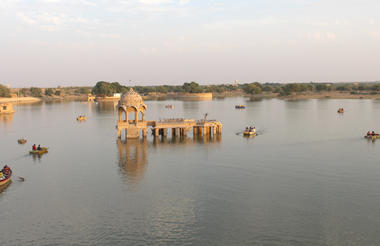

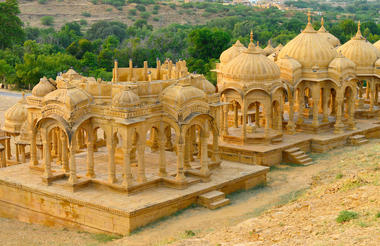
Leisurely breakfast at hotel.
Later proceed for Jaisalmer City Tour.
Jaisalmer Fort, which was built by Rawal Jaisal in 1156. It sits atop Trikuta Hill, commanding views across the desert landscape in all directions. Known as Sonar Quila or the Golden Fort, it seems to rise from the sand, reflecting the desert’s hues in its golden colouring. The fort is a whole township that consists of a palace complex, temples, the havelis of rich merchants and the residential complexes.
Not far from the city are the towering sand dunes at Sam, where sunset is a spectacular event, particularly on a camel safari. Camels were the transportation when Jaisalmer was built and riding to and through the dunes reveals superb vistas and a real appreciation of the remote and desolate nature of a desert.
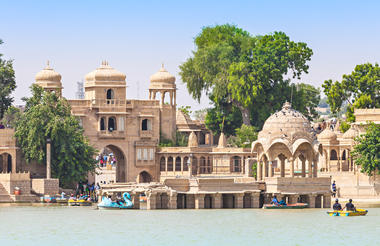
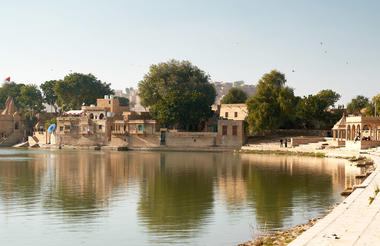
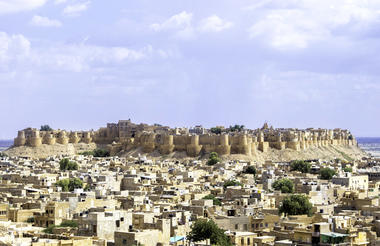
After breakfast, check out & drive to Khimsar.
Perched on the edge of the Great Thar Desert, in the heart of rural Rajasthan, is the remote 16th century Khimsar Fort, its battle-scarred walls & turrets are a reminder of a glorious and turbulent past. The construction of this magnificent fort began in 1523 by Rao Karamsji, the 5th son of Rao Jodha, the founder of Jodhpur. An excellent stopover for a night or two of relaxation between Jodhpur and Bikaner. Peacocks, parrots, pigeons and many varieties of birds greet you, adding to the charm and splendor of this ancient fort.
Check in at the hotel & rest of the day at leisure.
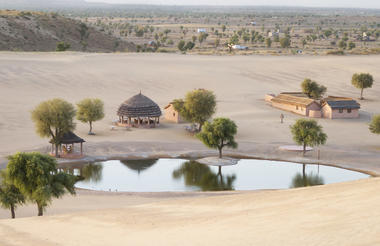

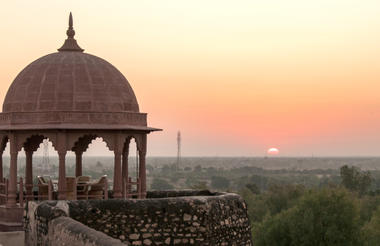
After breakfast, check out & drive to Pushkar.
On the edge of the desert is the tiny and tranquil town of Pushkar, set on the shore of picturesque Pushkar Lake. It is a very important pilgrimage centre for the Hindus. Every year thousands of sadhus and devotees are drawn to the lake around the full moon of Kartik Purnima in October-November. This is when the Pushkar Camel Fair is held. It is the largest in India and unique in is format, combining a major religious festival with a commercial market.
Check in at the hotel.
Later proceed for Half day Pushkar sightseeing.
Pushkar has many temples, but the most famous among them is the only existing Brahma Temple, dedicated to Lord Brahma. It was constructed in the 14th century and stands on a high plinth, with marble steps leading up to it. A beautiful carved silver turtle sits on the floor facing the sanctum.
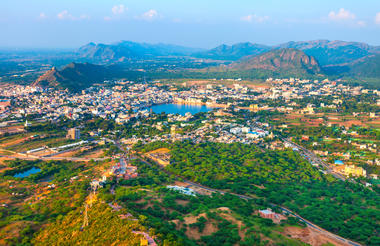
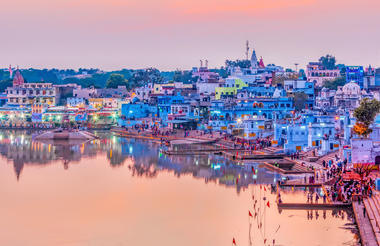
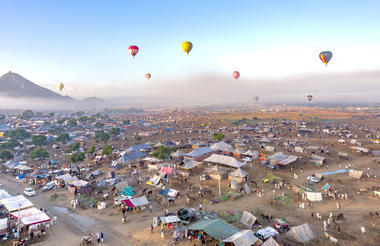
After breakfast, check out & drive to Jaipur.
Jaipur is the state capital of Rajasthan and owes its name, planning and foundation to the Maharaja Jai Singh II. In 1727 he decided to move from his hillside fortress at Amber to the plains, and thus Jaipur was conceived. It is also known as the "Pink City", derived from the pink painted sandstone from which the buildings in the old walled city are constructed. The city is endowed with great architectural elegance and beauty, with magnificent historic palaces, temples, gardens, museums and an amazing observatory built by Jai Singh.
Check in at the hotel & spend rest of the day at leisure.
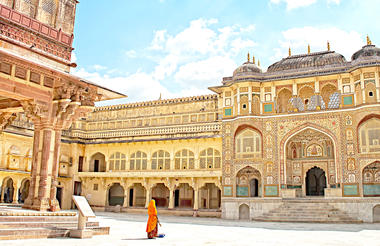


Full day sightseeing of Jaipur City.
Morning, sightseeing of Amber Fort.: Seven miles outside the city, in the rugged hills that surround Jaipur, is the magnificent Amber Fort. A Jeep will take you up the steep road to the fort, passing through huge gateways and pillared pavilions. This Rajput Fortress Palace was constructed from 1592 by Raja Man Singh II, and is a superb example of Rajput architecture. Within the Fort is Jai Mandir (Sheesh Mahal - Palace of Mirrors), renowned for its architectural designs using mirrors of varied shapes and sizes in the intricate design of its wall decoration.
Afternoon, sightseeing of Jaipur City: A city tour takes you through the bazaars to the Maharaja's City Palace. Part of it is now a fine museum with a comprehensive display of historic artifacts. A relatively small portion of the palace is still used by the Royal family of Jaipur.
Built in the style of a fortified campus, one of the palaces is the HAWA MAHAL, known as the Palace of the Winds. Built in 1799 this five story building looks out over the main street, and was originally for the ladies of the royal household to be able to watch life outside the cloistered Royal Residence.
Nearby is the JANTAR MANTAR, which has the largest stone and marble crafted observatory in the world. Built by Jai Singh in 1728, it is still equipped with its original ancient instruments including a very accurate 90-foot sundial. Many of them are still in working condition.


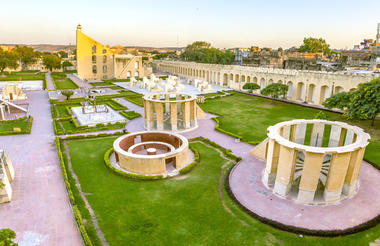
After breakfast, check out & drive to Agra.
Enroute visit Fatehpur Sikri.
Fatehpur Sikri: Located 40 Km from Agra, it was built by Emperor Akbar in 1569, in honour of the great Saint Sheikh Salim Chisti, who blessed Akbar and prophesised the birth of a son, who later became Emperor Jahangir. It is in a superb and complete state of preservation, and within the walls are palaces and the Jama Masjid. The main entrance is the 54 metre high Buland Darwaza, the Gate of Victory.
Following your visit, continue your drive to Agra.
Agra was the capital of the Afghan King Sikandar Lodhi’s empire from 1501. It passed to the Mughal’s soon after and in 1526 Emperor Babar transformed Agra, giving it a unique character and beauty. A great patron of the arts, he made changes to the culture and life-style of his people, which in turn brought forth some of the finest craftsmen, artists, statesmen, warriors and nobility ever seen in this part of India.
Over the next few centuries Agra witnessed a rise in pomp and pageantry under the rule of three great Mughal monarchs - Emperors Akbar, Jehangir and Shah Jahan. All lavished their love and riches on this fabled city, making it one of the great centers of art, culture, learning and commerce.
Check in at the hotel.
Later proceed for Sunset Visit to the Taj Mahal.
Taj Mahal was built by Shah Jahan between 1631 to 1653 in memory of his queen Mumtaz Mahal to enshrine her mortal remains. This architectural marvel is a perfectly proportioned masterpiece fashioned from white marble and in-laid with precious and semi-precious stones. It stands testimony to the skill of some 20,000 craftsmen brought together from Persia, Turkey, France and Italy, and who laboured for 22 years to complete this ‘Love Poem in Marble'. (Closed on Fridays)
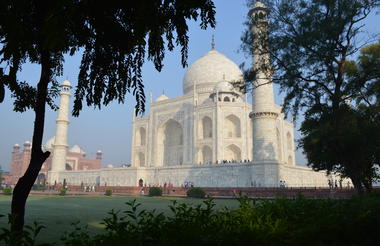
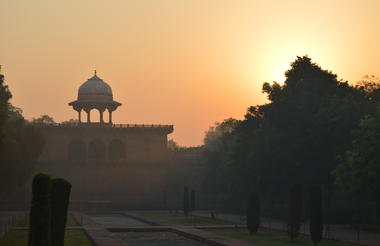
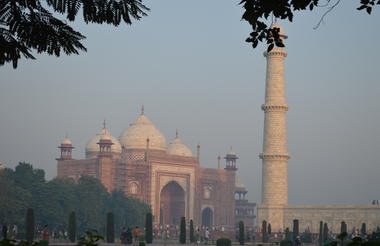
Leisurely morning at the hotel.
Later in the afternoon visit Agra Fort and Itmad–ud–Daulah Tomb.
Agra Fort was built principally as military establishments by Akbar in 1565. However, it was partially converted into a palace during Shah Jahan’s reign. Though Akbar built the original structure, his grandsons made many additions. This powerful fortress encompasses the imperial city of the Mughal rulers within its 2.5kms enclosure walls.
Itimad-Ud-Daulah This is the first example of Mughal architecture using marble. It was built by Empress Nur Jahan, in memory of her father Ghias-Ud-Din Beg, between 1622 and 28. She was daughter-in-law of Emperor Akbar, and he the grandfather of Mumtaz Mahal. A graceful building much smaller than the Taj Mahal is also the first example in Mughal architecture of a building faced entirely in marble. The inlay work is exquisite.
Later you will be transferred to railway station for your Overnight Train to Katni.
Agra – Katni NZM JBP EXP22182 Departs:2030 Arrives 0635 Hrs+1 1st AC Class
Overnight on board Train
Arrive Katni at 0635Hrs.
On your arrival, you will be met by a representative who will escort you to your hotel in Bandhavgarh National Park.
Bandhavgarh National Park is located in the Vindhya Hills in the state of Madhya Pradesh. With its diverse variety of habitat it is home to a large cross section of game, including Royal Bengal tigers. Indeed, the tiger population at Bandhavgarh is one of the highest in India. The park comprises a core area of 105 sq km and a buffer area of around 400 sq km. Its topography includes steep ridges, undulating forest and open meadows making it one of India's most scenic national parks.
Check in at the Lodge. We’ve arranged your breakfast at your lodge.
Afternoon Game Drive by Exclusive Gypsy.
Afternoon visits to the National Park. Its steep cliffs, rocky hills covered with 44,884 hectare of dense Sal and bamboo forests make it ideal terrain for tigers. Other inhabitants include leopard, jackal, jungle cat, wild boar, sloth bear, nilgai and sambar. Bandhavgarh attracts many migratory birds in the winter months, including birds of prey - steppe eagle and a variety of wildfowl.
Lunch & Dinner at the Lodge.
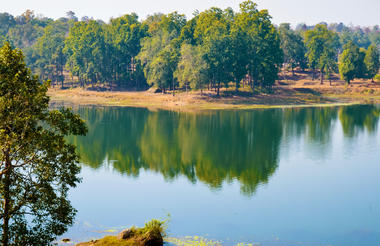
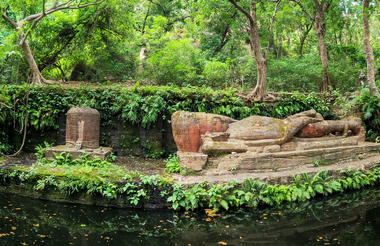
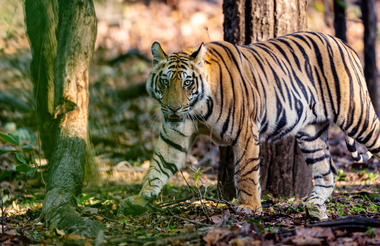
Morning and Afternoon Game Drives by Exclusive Gypsy.
Breakfast, lunch and dinner at the lodge.
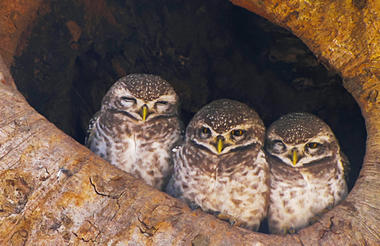
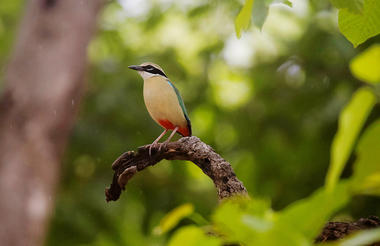
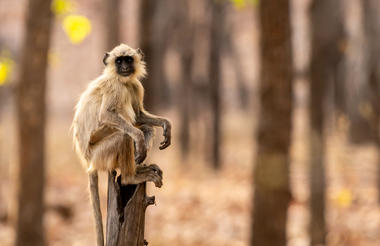
After breakfast, check out & drive to Khajuraho.
The temples at Khajuraho are fine examples of Indo-Aryan architecture. Often called the Temples of the Karma Sutra, they are one of India’s major attractions. Built by the rich and powerful Chandela Emperors, whose dynasty survived for five generations before falling to the onslaught of Islam, the temples are magnificent, and richly carved with erotic images, the recurrent theme being woman in all her glory. There are some 85 temples, most dating from a one century long burst of creative genius between 950 and 1050 AD. Each temple has a number of spires in ascending order representing man’s aspirations.
Check in at the hotel & take rest.
Later proceed to visit Eastern & Southern Group of Temples.
The Eastern Group: Comprising seven temples, the main being the Parsvanath, Adinatha and Santinatha Jain temples in a walled enclosure, and four others, the Ghantai, Brahma, Vamana and Javari, which are scattered through the village. All covered with carved images in a variety of sensuous attitudes: languid, provocative, mischievously inviting, give credibility to the theory that Khajuraho's erotica were meant to test the devotees who came to worship their gods at the temples.
The Southern Group: Only two temples form this group. The fine Chaturbhuj Temple has a massive intricately carved image of Vishnu in the sanctum, and the Duladeo Temple, the most recent of Khajuraho’s temples, is rather isolated and lacks the skilled craftsmanship of the earlier temples.
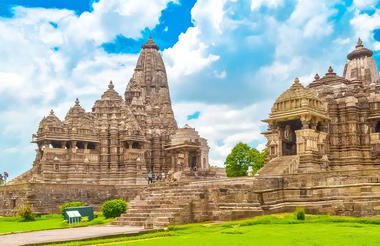
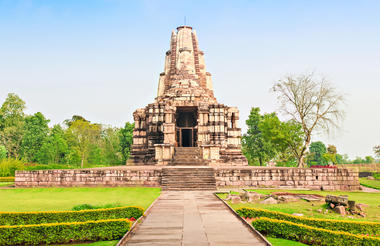
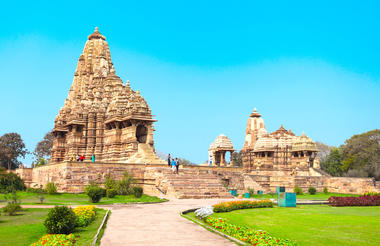
After breakfast, proceed to visit Western Group of Temples.
The Western Group: Comprising 10 temples, these are the best known, and most interesting. The two largest, the Kandariya Mahadev, and Lakshmana belong to this group. Kandariya Mahariya is artistically and architecturally the most perfect. Built around 1030 AD it presents Chandella art at its most refined. The main spire is 31 metres high with prolific carving. There are some 872 statues and carvings both on the inside and outside. Though similar in design the Lakshmana temple is dedicated to Vishnu, and is one of the oldest temples, dating from around 930 AD. It is also the best preserved.
Later check out and you will be transferred to the airport for your flight to Varanasi.
Khajuraho – Varanasi Jet Airways9W-2424Departs 1405 Arrives1455 Economy class
On arrival, you will be met & transferred to your hotel.
Evening Attend Ganga Aarti (Organised by Hotel, With hotel Guide): In the evening the Ghats and temples are atmospheric, lit with candles and oil-lamps. There will be the opportunity to participate in an Arti Ceremony (collective prayer) and watch the floating Diyas (lamps) on the River Ganges.
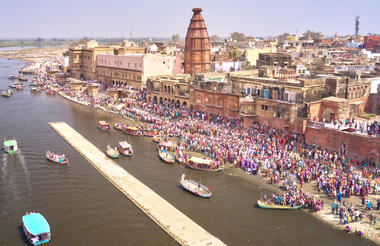
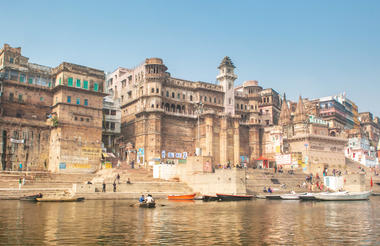
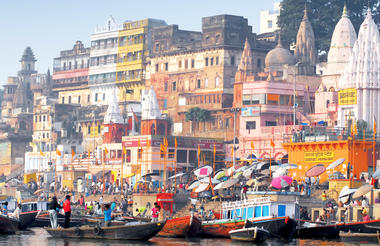
Morning Sunrise Boat Ride
The best time to visit the Ghats is at dawn, so an early start today. At this time the city is waking up and the light is magical, playing on the water and the buildings. The boat will cruise along the waterfront and the spiritually uplifting activity along the Ghats is viewed. From dawn to dusk the Ghats are thronged by thousands of devotees, who perform their holy rituals in the hope of attaining eternal salvation; Nirvana.
Following boat ride, walk to the Kashi Vishveswara Temple.
Kashi Vishveswara Temple (Golden Temple); In the heart of the city is the majestic Vishveswara Temple, dedicated to Shiva, the Lord of the Universe, who, according to legend, after his marriage to Devi Parvati left his Himalayan abode and came to reside in Kashi with all the gods in attendance. Maharani Ahilya Bai Holkar of Indore built the Temple in its present form in 1776, and has been a living embodiment of India’s timeless cultural traditions and high spiritual values.
Return to the hotel for breakfast.
Later in the day visit Benaras Hindu University, Bharat Mata Temple & Sarnath.
Bharat Mata Temple: Dedicated to “Mother India” it was opened by Mahatma Gandhi in 1936. Instead of customary gods and goddesses, the unique aspect of this temple is a perfect relief map of India. It can be viewed from above and from a sunken “room” looking across India from the far south to the Himalayas in the north.
Benaras Hindu University: The largest residential university in Asia, and a major seat of Sanskrit study, it is internationally reputed. Founded by the great nationalist leader, Pandit Madan Mohan Malviya, in 1916, the area of the main campus is 1,300 acres, with well maintained roads, extensive gardens, a temple, an air-strip and buildings that are an architectural delight. The new Vishveswara Temple in the University grounds is dedicated to lord Shiva, and is a replica of the original Vishveswara Temple.
Situated 10 km from Varanasi, Sarnath is one of the four most important Buddhist pilgrimage centres in India. Having found enlightenment at Bodhgaya, it is where Lord Buddha delivered his first sermon to his disciples, preaching the middle path for attaining 'Nirvana'. Realising the sanctity of the site, emperor Ashoka built fine Stupas and other monuments. The 'Dhamekh' Stupa is perhaps the most remarkable structure. It was at its height in 640 AD when some 1,500 priests were in residence.



Leisurely morning at hotel with breakfast.
Later check out & you will be transferred to airport for your flight to Delhi.
Varanasi – Delhi Air India AI 433 Depart:1535 Arrive 1700 Economy
On arrival, you will be met & escorted to your hotel.
Delhi, the capital and the third largest city of India, is a fusion of ancient and modern. Standing at the western end of the Gangetic Plain, it is a vibrant city rich in culture, architecture, beautiful gardens and human diversity. Its rich history is reflected in magnificent monuments, in museums and in galleries. It comprises two contrasting yet harmonious parts, Old Delhi and New Delhi. Old Delhi was the capital of Muslim India from the 12th to the 19th centuries, while New Delhi was created by the British Raj and replaced Calcutta as the capital in 1931. It is India’s main international gateway, and the travel hub of Northern India.
Check in at the hotel & spend rest of the evening at leisure (No Vehicle for Local use).



After breakfast, check out &you will be transferred to International Airport for your flight to Singapore by SQ-401 departs at 1210Hrs.






